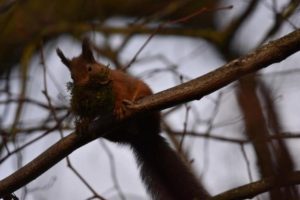The grey squirrel is a common mammal that can delight you by its acrobatic movements and annoy by damaging trees, feeding on flower buds, bulbs, fruits and vegetables at the same time. Sciurus carolinensis, a common name grey squirrel, is a tree squirrel in the genus Sciurus. It is native to eastern North America.
These furry terrorists attack a wide range of ornamental plants, fruits, and vegetables. Tulip bulbs, crocus corms, sweet corn, strawberries, apples, pears, nuts, sunflower seed heads and flower buds of camellias and magnolias are affected the most.
Grey squirrels damage trees by gnawing at the stem to get to the sweet, sap-filled layers (phloem tissue) just beneath the bark with their sharp incisors as a part of their oral maintenance. This tissue is responsible for the movement of sugars around the plant known as translocation. If this gnawing extends around the stem, then the movement of sugars around the plant will come to a halt and the tree will die.
Bark stripping damage usually starts at the end of April and continues until the end of July. Trees are stripped anywhere on the main stem and branches, with vigorously growing and dominant trees generally being most affected. Damage levels vary between years and across sites within the same year. Planted or naturally regenerated trees aged between 10 and 40 years, especially sycamore, beech, oak, sweet chestnut, pine, larch, and Norway spruce, are most vulnerable to damage. Other species, especially broadleaves may also be damaged. The damages caused by the bark stripping act as a major discouragement to the planting of broadleaved and coniferous trees for timber as it reduces the value of the final crop.
Up to 5% of damaged trees may die and many more will have degraded timber value through stem deformation, rot, and broken tops. Oak, poplar, Scots pine and Norway spruce are particularly vulnerable to stem breakage. The fungal invasion at the damage site results in staining and rotting, reducing the value of the timber. Damage to branches in the canopy may cause dieback, affecting the timber yield.
Other damages caused by grey squirrels include digging up and feeding on bulbs and corms. Squirrels can also affect populations of small birds in woodlands by eating eggs and nestlings. Also, these little critters damage lawns by burying or digging up winter food stores and gnaw on plastic, such as hosepipes and plastic netting as a part of their oral maintenance. In addition, there may be indirect competition, e.g. for food, between grey squirrels and the red squirrel. Grey squirrels also carry squirrel pox virus, an infection fatal to red squirrels.
Grey squirrel still a problem despite growing pine marten population
By Steven Moore
June 22, 2020

Research led by Queen’s University Belfast has found that whilst red squirrels are responding positively to the increased presence of the pine marten across Ireland and Britain, its ability to control the grey squirrel is limited by the lack of forest cover and the presence of urban refugia.
The research, carried out in partnership with National Museums Northern Ireland, was published earlier this week in Journal of Applied Ecology.
It found that despite the on-going recovery of the pine marten, and its ability to provide natural biological control of the invasive grey squirrel, isolated populations of grey squirrels in parklands in towns and cities are still likely to persist.
The study used data from 332 sites across Northern Ireland covering all sizes and shapes of woodlands in both urban and non-urban areas.
Grey squirrels are damaging Britain’s native trees, warns Prince of Wales
By Louise Gray, The Telegraph, UK
As patron of a new charity, The Red Squirrel Survival Trust (RSST), the Prince spoke out about the damage greys can cause. Grey squirrels strip the bark from native broadleaved trees like beech, oak, and sweet chestnut and can even kill the trees as well as eating bulbs and seeds in large quantities.
In a letter of support for the new charity, the Prince wrote: “The grey squirrels, which exist in far greater number than the reds, are causing incalculable damage to our native trees particularly the beech.”
The Prince recalls seeing reds in Sandringham, Norfolk, as a child but can now only see the species in the Royal estates in Scotland.
There is an urgent need for an effective solution against this little four-legged mammal which continues to destroy the trees, fruits, and vegetables without any sign of repentance.
C Tech Corporation can offer a solution to overcome this problem. Our product RodrepelTM is extremely low toxicity and extremely low hazard and eco-friendly rodent aversive. RodrepelTM is available in the form of solid masterbatches, liquid concentrate and in lacquer form. The product is compliant with RoHS, RoHS2, RoHS3, and REACH and is FIFRA exempted. This product acts through a series of highly developed intricate mechanism ensuring that rodents are kept away from the target application.
The fencing and tree guards can be coated with RodrepelTM to protect the trees, shrubs, etc. from the damage caused by the grey squirrels. The product can also be incorporated into agricultural films, greenhouse films, plastic mulches used on a large scale in agriculture as well as the horticulture sector in order to avoid damages caused by these squirrels to fruits and vegetables. Also, the products can be directly incorporated in the polymer matrix during the processing of pipes and tubing. RodrepelTM does not leach out, thus there is no soil pollution. Groundwater reserves are also not polluted. Also, the non-target beneficial species like earthworms, bees, etc are not affected.
Contact us at technical.marketing@ctechcorporation.com if you’re facing problems with rodents and get the best remedies to combat the pest menace.
Also, visit our websites:
http://www.ctechcorporation.com/
http://www.rodrepel.com/
http://www.termirepel.com/
http://www.combirepel.com/
Follow our Facebook pages at:
1] https://www.facebook.com/Combirepel-411710912249274/
2] https://www.facebook.com/Termirepel-104225413091251/
3] https://www.facebook.com/Rodrepel-120734974768048/
Follow us on our Twitter pages at:
1] https://twitter.com/rodrepel
2] https://twitter.com/termirepel
3] https://twitter.com/combirepel
